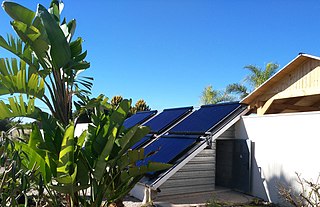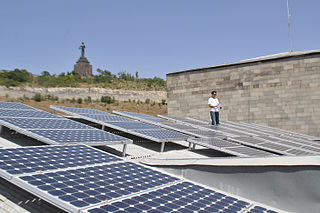
The use of solar power at the White House was first introduced in 1979. The solar panels were removed in 1986. Solar power was reintroduced early in the 21st century.

The use of solar power at the White House was first introduced in 1979. The solar panels were removed in 1986. Solar power was reintroduced early in the 21st century.
Mechanical engineer Fred Morse was approached by the Richard Nixon administration to assess the potential of solar power. He took several years to work out what could be installed on the roof of the White House. [1] The panels could not alter or change the look of the house, and were ultimately white as opposed to a darker colour for aesthetic reasons. [1]
The need for alternative sources of energy than fossil fuels and energy independence grew in the wake of the oil crises of 1973 and 1979. [1] Jimmy Carter's reviewing stand for his inauguration was warmed by solar panels. [1] The Carter administration increased the budget for the development of energy technology research and introduced tax credits for solar power. [1]
On June 20, 1979, 32 solar water heating panels were placed on the roof of the West Wing. The panels were made by InterTechnology/Solar Corp. from Warrenton, Virginia and installed by Hector Guevara of Alternate Energy Industries Corp. [2] At the dedication ceremony for the panels, President Carter said, "In the year 2000 this solar water heater behind me, which is being dedicated today, will still be here supplying cheap, efficient energy ... A generation from now, this solar heater can either be a curiosity, a museum piece, an example of a road not taken or it can be just a small part of one of the greatest and most exciting adventures ever undertaken by the American people". [1]
The panels provided almost 75 percent of the energy to heat 1,000 gallons of water in the staff kitchen of the White House. [2] [3] [4] The Carter administration had set a goal for renewable energy in the United States to generate 20 percent of the nation's energy needs by the year 2000. [1] Tax breaks for solar panels were eliminated under the Ronald Reagan administration. [1] By 2013, seven percent of US energy needs were derived from renewable sources. [1] 0.1 percent of that energy was generated from solar power. [1]
The panels were removed in 1986 during the Reagan administration during the resurfacing of the roof, and stored in a warehouse in Franconia, Virginia. [4] [5]
An official from Unity College asked that they be released to them, and they were moved to the college in an old school bus and installed in 1992. [4] The panels were used to reheat water for the college's dining hall. [4] The college received a letter from Carter expressing his happiness at their installation. [4] In October 2004, the college planned to auction the solar panels as they had become outdated. [4]
Three of the panels are part of museum collections. One of the panels was donated by Unity College to the National Museum of American History in 2009. [6] Another is on display at the Jimmy Carter Presidential Center. A third panel has been part of the Solar Science and Technology Museum in Dezhou, China since 2013. [1]
In 2003, the George W. Bush administration reinstalled solar thermal heaters. [5] These units are used to heat water for landscape maintenance personnel and for the presidential pool and spa. One hundred sixty-seven solar photovoltaic grid-tied panels were installed at the same time on the roof of the maintenance facility. The changes were not publicized, as a White House spokeswoman said the changes were an internal matter. The story was picked up by industry trade journals. [7]
In 2010, Steven Chu, the secretary of energy under the Barack Obama administration, announced that solar panels would be reinstalled on the roof saying that "As we move towards a clean energy economy, the White House will lead by example". [3] The panels were installed in 2013, making it the first time solar power would be used for the president's living quarters. [8] [5] [7]

Solar energy is radiant light and heat from the Sun that is harnessed using a range of technologies such as solar power to generate electricity, solar thermal energy, and solar architecture. It is an essential source of renewable energy, and its technologies are broadly characterized as either passive solar or active solar depending on how they capture and distribute solar energy or convert it into solar power. Active solar techniques include the use of photovoltaic systems, concentrated solar power, and solar water heating to harness the energy. Passive solar techniques include orienting a building to the Sun, selecting materials with favorable thermal mass or light-dispersing properties, and designing spaces that naturally circulate air.

Water heating is a heat transfer process that uses an energy source to heat water above its initial temperature. Typical domestic uses of hot water include cooking, cleaning, bathing, and space heating. In industry, hot water and water heated to steam have many uses.

Solar water heating (SWH) is heating water by sunlight, using a solar thermal collector. A variety of configurations are available at varying cost to provide solutions in different climates and latitudes. SWHs are widely used for residential and some industrial applications.

Sustainable architecture is architecture that seeks to minimize the negative environmental impact of buildings through improved efficiency and moderation in the use of materials, energy, development space and the ecosystem at large. Sustainable architecture uses a conscious approach to energy and ecological conservation in the design of the built environment.

Microgeneration is the small-scale production of heat or electric power from a "low carbon source," as an alternative or supplement to traditional centralized grid-connected power.
Renewable heat is an application of renewable energy referring to the generation of heat from renewable sources; for example, feeding radiators with water warmed by focused solar radiation rather than by a fossil fuel boiler. Renewable heat technologies include renewable biofuels, solar heating, geothermal heating, heat pumps and heat exchangers. Insulation is almost always an important factor in how renewable heating is implemented.

Many countries and territories have installed significant solar power capacity into their electrical grids to supplement or provide an alternative to conventional energy sources. Solar power plants use one of two technologies:

Spain is one of the first countries to deploy large-scale solar photovoltaics, and is the world leader in concentrated solar power (CSP) production.

Solar power is a fast developing industry in India. The country's solar installed capacity was 71.61 GWAC as of 31 August 2023. Solar power generation in India ranks fourth globally in 2021.

According to data from the US Energy Information Administration, renewable energy accounted for about 13.1% of total primary energy consumption and about 21.5% of total utility-scale electricity generation in the United States in 2022.

China is the largest market in the world for both photovoltaics and solar thermal energy. China's photovoltaic industry began by making panels for satellites, and transitioned to the manufacture of domestic panels in the late 1990s. After substantial government incentives were introduced in 2011, China's solar power market grew dramatically: the country became the world's leading installer of photovoltaics in 2013. China surpassed Germany as the world's largest producer of photovoltaic energy in 2015, and became the first country to have over 100 GW of total installed photovoltaic capacity in 2017.

Solar power includes solar farms as well as local distributed generation, mostly on rooftops and increasingly from community solar arrays. In 2022, utility-scale solar power generated 145.6 terawatt-hours (TWh), or 3.4% of electricity in the United States. Total solar generation that year, including estimated small-scale photovoltaic generation, was 204 TWh.
Energy recycling is the energy recovery process of utilizing energy that would normally be wasted, usually by converting it into electricity or thermal energy. Undertaken at manufacturing facilities, power plants, and large institutions such as hospitals and universities, it significantly increases efficiency, thereby reducing energy costs and greenhouse gas pollution simultaneously. The process is noted for its potential to mitigate global warming profitably. This work is usually done in the form of combined heat and power or waste heat recovery.

Solar hot water is water that is heated using energy from the sun. Solar energy heats up large panels called thermal collectors, commonly known as solar panels. The energy is transferred through a fluid to a reservoir tank for storage and subsequent use. It is then used to heat water for commercial or domestic use and also as an energy input for heating and cooling devices and for industrial "process heat" applications.

Nancy Helen Sutley led the White House Council on Environmental Quality (CEQ) for five years during the administration of Barack Obama. She was unanimously confirmed for that post by the United States Senate on January 22, 2009. The CEQ coordinates federal environmental efforts and works with agencies other than White House offices in the development of environmental policies and initiatives; the chair serves as the principal environmental policy advisor to the president.

The use of solar energy began in Israel in the 1950s with the development by Levi Yissar of a solar water heater to address the energy shortages that plagued the new country. By 1967 around 5% of water of households were solar heated and 50,000 solar heaters had been sold. With the 1970s oil crisis, Harry Zvi Tabor developed the prototype of the solar water heater now used in over 90% of Israeli homes. There are over 1.3 million solar water heaters installed as a result of mandatory solar water heating regulations.

Turkey’s sunny climate possesses a high solar energy potential, specifically in the South Eastern Anatolia and Mediterranean regions. Solar power is a growing part of renewable energy in the country, with 10 gigawatts (GW) of solar panels generating 5% of the country's electricity. Solar thermal is also important.
The following outline is provided as an overview of and topical guide to solar energy:

Energy in the U.S. state of Hawaii is produced from a mixture of fossil fuel and renewable resources. Producing energy is complicated by the state's isolated location and lack of fossil fuel resources. The state relies heavily on imports of petroleum. Hawaii has the highest share of petroleum use in the United States, with about 62% of electricity coming from oil in 2017. As of 2021 renewable energy made up 34.5%.

Solar energy is widely available in Armenia due to its geographical position and is considered a developing industry. In 2022 less than 2% of Armenia’s electricity was generated by solar power.